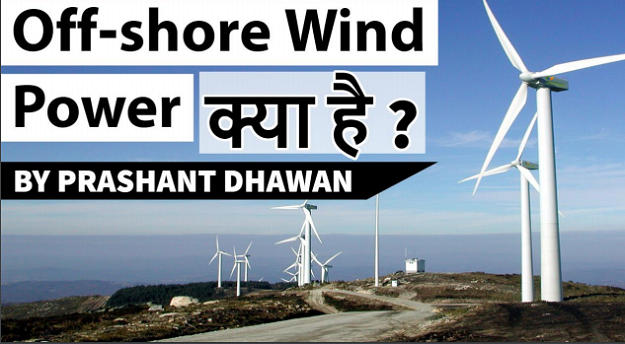Table of Contents
BASICS
Ministry of New and Renewable Energy sets 30 GW offshore wind energy target by 2030
The MNRE recently invited Expressions of Interest (EoI) for the first 1 GW offshore wind project in India, which has evoked keen response from the industry, both global and
Indian, the ministry said in a statement.
NOTES
•India has set itself a target of achieving 175 GW renewable energy target by 2022, which the
government is expected to exceed by additional 50 GW within the same timeline, Minister for
Power and New & Renewable Energy RK Singh recently announced


OFFSHORE WIND POWER


WHY OFF- SHORE WIND FARMING IS
BENEFICIAL?
•The offshore wind faming is attractive because of several reasons such as stronger winds for
efficient generation of power; no impact on real estate value of land as in case of onshore wind
farming; its ability to fulfil the demand of the heavily populated coastal regions and no
significant environment costs.
NATIONAL OFF-SHORE WIND POLICY:
• The Ministry of New & Renewable Energy had notified National OffShore Wind Policy in October 2015 to realize the offshore wind power potential in the country.
• With this, the Ministry of New & Renewable Energy (MNRE) has been authorized as the Nodal Ministry for use of offshore areas within the
Exclusive Economic Zone (EEZ) of the country and the National Institute of Wind Energy (NIWE) has been authorized as the Nodal Agency for development of offshore wind energy.
• Government has paved way for development of the offshore wind farms up to the seaward distance of 200 Nautical Miles (within its Exclusive Economic Zone) from the base line.
•The headquarters of National Institute of Wind Energy (NIWE) are located at which city?
[A]Kochi
[B]Chennai
[C]Bengaluru
[D]Hyderabad
CHALLENGES:
• It is difficult to install large wind power turbines in open seas. Offshore wind turbines are of much larger dimensions and capacities than onshore turbines.
• The PLF (plant load factor) of off-shore wind turbines will be higher than the on-shore projects.
• The cost per MW of off-shore wind power project will be higher by 50-100% as compared to on-shore projects depending on the water depth.
• Further deep sea wind farms come with the challenges of assigning no-go areas for commercial shipping. There would be a need to devise new lanes, proper lightning for ships to pass on.
GLOBALLY
• Globally, UK tops the list of offshore wind markets, followed by Germany, Taiwan, China and the USA.
• Given India’s coastline of 7,600 km, the country has enormous potential for offshore wind energy and it can potentially repeat the success achieved in onshore wind
energy





















 WhatsApp
WhatsApp